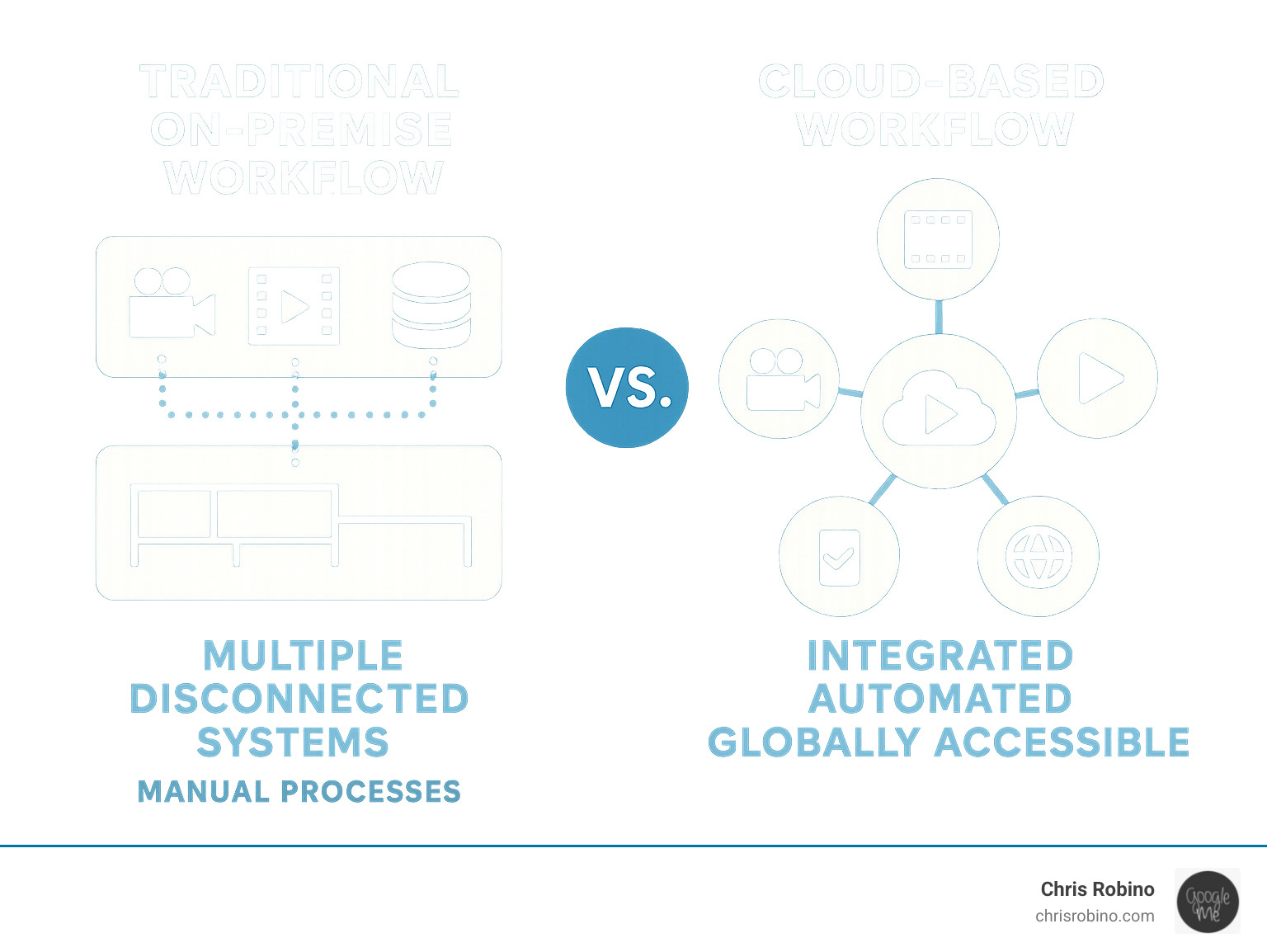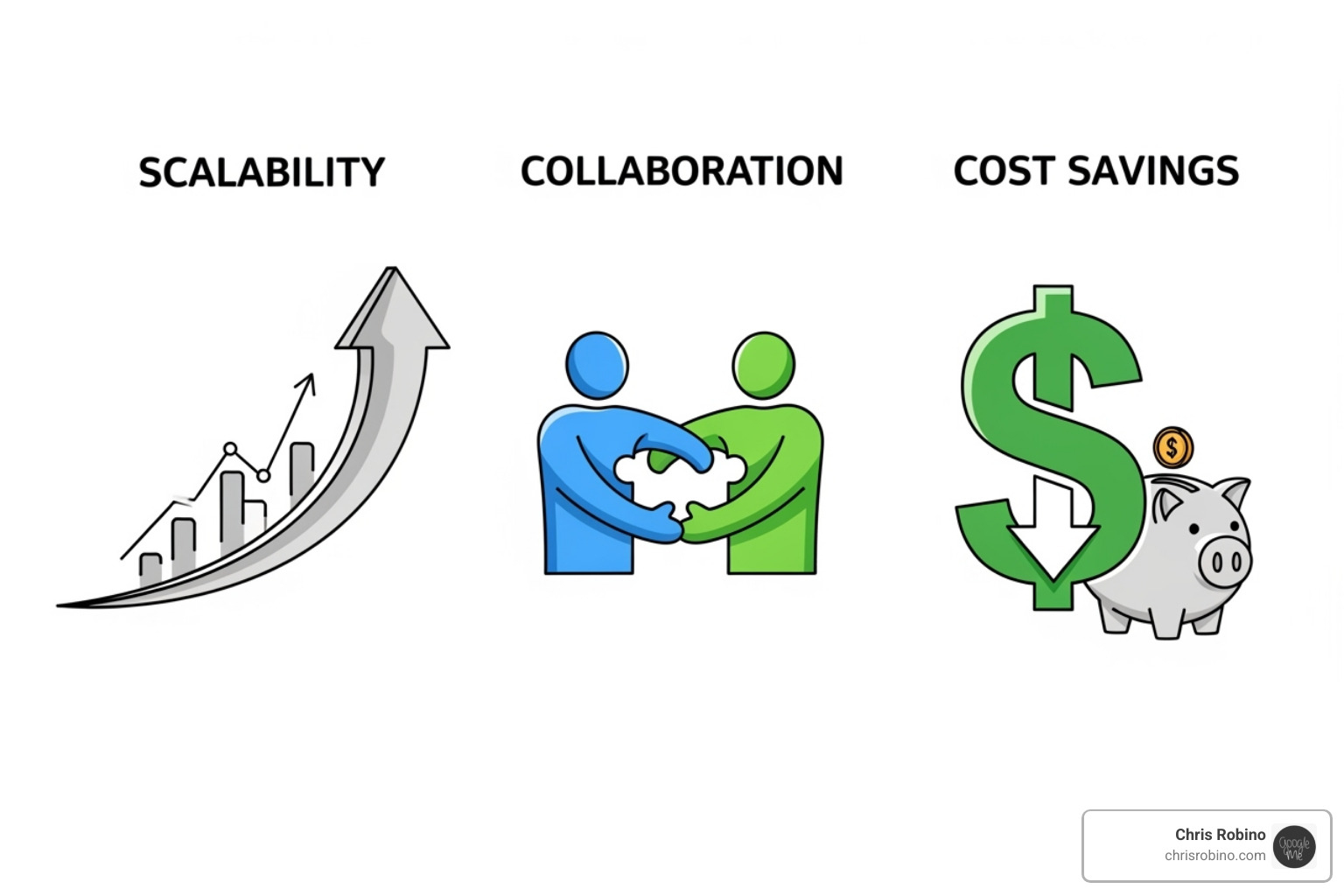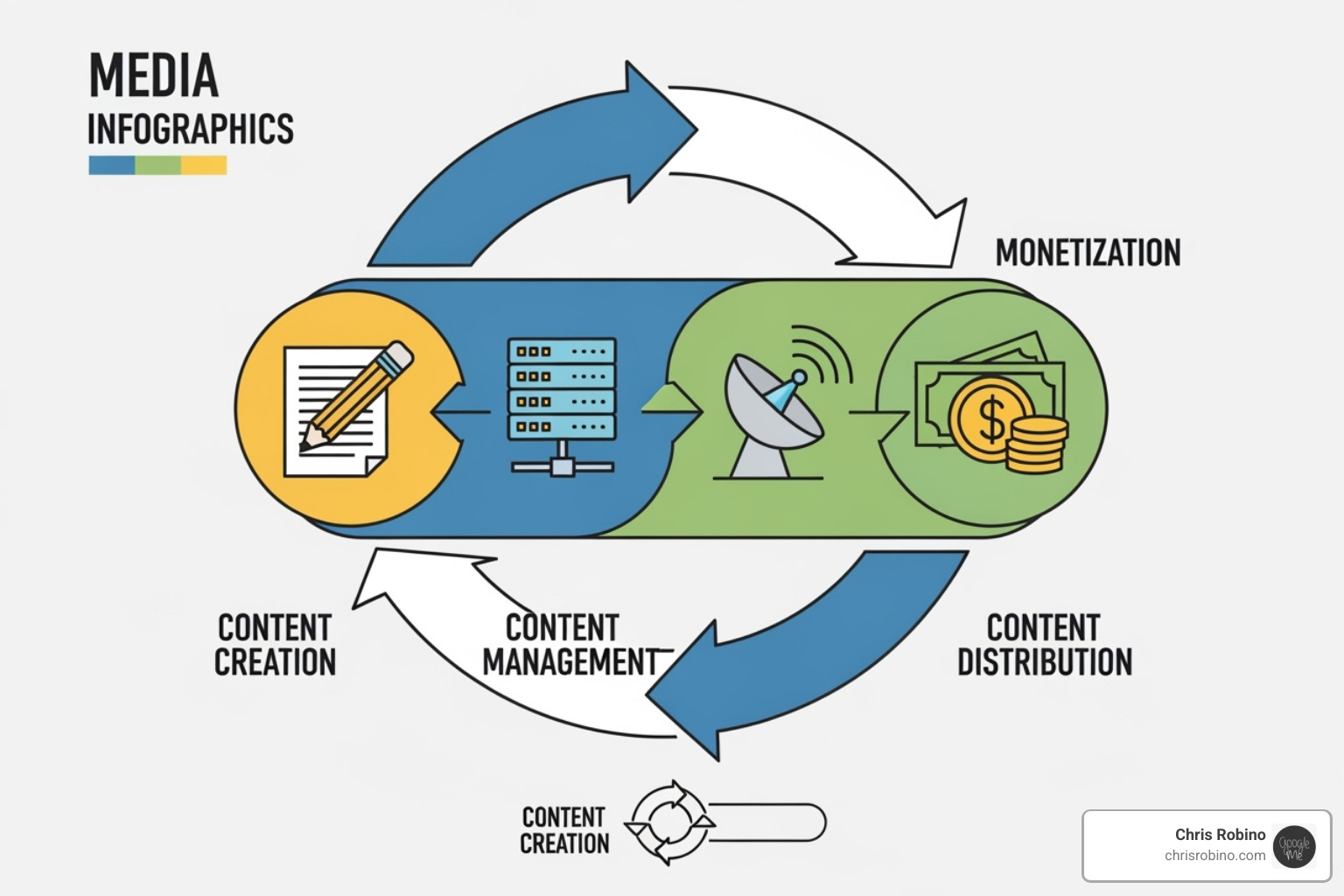The Digital Change Revolutionizing Media & Entertainment
Cloud solutions for media are fundamentally changing how content is created, managed, and delivered across the entertainment industry. From streamlining production workflows to enabling global collaboration, these technologies have become the backbone of modern media operations.
Key Cloud Solutions for Media:
- Content Production: Virtual workstations, cloud rendering, and remote editing capabilities
- Media Asset Management (MAM): Centralized storage with AI-powered metadata and workflow automation
- Distribution & Streaming: Global CDNs, live broadcasting, and direct-to-consumer platforms
- Data & Analytics: AI-driven personalization, audience insights, and monetization tools
- Security & Compliance: Enterprise-grade encryption, access controls, and industry-standard protections
The media industry has experienced unprecedented growth, with projections showing continued expansion driven by digital consumption patterns. Cloud computing has emerged as the essential infrastructure enabling this change, allowing companies to scale operations globally while reducing costs and improving efficiency.
Major media organizations are already seeing remarkable results. The infrastructure of major cloud providers serves billions of global users, while specialized platforms support over 150,000 professionals managing millions of gigabytes of content. Companies implementing cloud workflows report up to 4x increased throughput with the same staffing levels.
This shift represents more than just technological upgrade – it’s a complete reimagining of how media businesses operate. Cloud solutions eliminate traditional barriers like geographical limitations, hardware constraints, and siloed workflows that have long hindered the industry.
I’m Chris Robino, a Digital Strategy Leader with over two decades of experience helping organizations implement cloud solutions for media and AI-driven systems that maximize ROI and streamline complex workflows. Throughout my career, I’ve guided companies through digital changes that harness cloud technology to lift search performance, automate processes, and drive measurable growth in the rapidly evolving media landscape.

Why the Cloud is Essential for Modern Media Operations
The media and entertainment landscape demands an agility that traditional infrastructure cannot provide. Viral sensations can crash servers, and global content creation requires seamless collaboration. Cloud solutions for media are essential for handling these swings in demand.
They provide the business agility and operational efficiency needed to break down silos between creative, technical, and distribution teams, creating a unified workflow.

Cloud adoption brings core benefits that change the game, enabling a pivot when the market shifts and making teams more efficient.
Instead of creative, technical, and distribution teams working in separate bubbles, everything flows together seamlessly, as if all departments are finally speaking the same language.
More info about innovation in media companies
Opening up Unprecedented Scalability and Flexibility
Traditional setups struggle with rendering complex animations or transcoding 4K footage, requiring expensive hardware that often sits idle. Cloud platforms offer elastic resources, eliminating these large capital investments.
For intensive tasks, companies can access massive computing power on a pay-as-you-go model. This on-demand computing approach provides what feels like infinite rendering power, allowing teams to scale up instantly to meet deadlines. The global reach of cloud data centers also ensures fast, reliable content delivery to viewers worldwide.
The infrastructure serving two billion global users on major platforms is a testament to this power. That same robust foundation powers cloud services that media companies can tap into, giving even smaller operations access to enterprise-level capabilities.
Fostering Global Collaboration and Remote Workflows
Cloud solutions for media make geographical boundaries irrelevant, enabling sophisticated remote post-production. Editors, colorists, and directors can collaborate with anytime, anywhere access from different parts of the world.
Real-time feedback capabilities and access to centralized assets mean the entire production process becomes more fluid and efficient. This approach is brilliant for breaking down silos between departments and locations.
Consider that specialized platforms support over 150,000 global users working together seamlessly. That’s the power of cloud-based collaboration at scale, where distance becomes a minor detail rather than a major obstacle.
Driving Cost-Efficiency and Operational Agility
Cloud computing shifts infrastructure costs from a large upfront capital expenditure (reduced CapEx) to a more predictable OpEx model. This frees up capital for creative projects rather than server rooms.
Workflow automation handles repetitive tasks, allowing teams to focus on creative work and enabling a faster time-to-market. The results are significant: companies implementing cloud workflows report 4x throughput with the same headcount.
This increased throughput means you can take on more projects, meet tighter deadlines, and respond to market opportunities faster than competitors still wrestling with traditional infrastructure limitations.
More info about cloud-based computing
A Universe of Cloud Solutions for Media Across the Entire Lifecycle
Cloud solutions for media create a complete ecosystem that transforms the entire media value chain. From pre-production to final delivery, these end-to-end solutions create a unified workflow, eliminating bottlenecks and allowing content to flow naturally between stages. This lets your team focus on creating content while the technology handles file management, versioning, and synchronization.

Modern cloud platforms create a unified workflow where content flows naturally from one stage to the next, eliminating frustrating bottlenecks and miscommunications that used to plague production timelines.
Content Creation and Post-Production in the Cloud
Virtual workstations have freed creative professionals from their desks, providing access to powerful computing resources from anywhere with an internet connection. Cloud rendering offers virtually unlimited computational power, drastically reducing render times for complex jobs.
Automated post-production workflows, such as for VFX pulls from an Edit Decision List (EDL), save significant manual effort and free up your team to focus on creative decisions. With remote editing capabilities and real-time feedback systems, top talent can collaborate effectively regardless of location, keeping projects moving forward smoothly.
Revolutionizing Media Asset Management (MAM) and Supply Chains
Cloud-based Media Asset Management (MAM) systems provide a centralized repository, creating a single source of truth for all media files. This eliminates version confusion and disorganized assets.
These systems feature automated transcoding to ensure content is always in the right format and use AI-powered metadata enrichment to make assets easily searchable. Workflow orchestration automates the entire process from ingest to delivery, making the media supply chain highly efficient. Leading cloud platforms manage over 30 million GB of content, showcasing the scalability of these solutions.
Powering Broadcast, Live Streaming, and Direct-to-Consumer (D2C) Platforms
Cloud infrastructure is essential for modern content consumption. Live cloud production offers the flexibility to create and broadcast events entirely in the cloud. Playout automation ensures linear channels run smoothly, with robust disaster recovery capabilities providing reliability.
Global Content Delivery Networks (CDNs), like those powering the world’s largest video platforms, ensure a smooth, reliable low-latency streaming experience for audiences worldwide. For companies building D2C platform infrastructure, the cloud provides a scalable foundation to handle peak demand without massive upfront investment, ensuring stability when a show goes viral or a finale airs.
The Strategic Advantage: Data, AI, and Monetization in the Cloud
Beyond content creation, the strategic advantage lies in understanding audiences and monetizing insights. Cloud solutions for media are key to making data-driven decisions that boost audience engagement and open new revenue streams.
More info about media industry trends
Leveraging AI and Analytics for Audience Insights and Personalization
The cloud’s massive processing power enables sophisticated AI and machine learning models to analyze audience behavior. Generative AI for content findy can create conversational experiences, serving up perfect recommendations.
When Newsweek implemented AI-powered personalized content recommendations, they saw revenue per visit jump by 10%, with click-through rates improving by 50-75%. In addition, machine learning models excel at audience segmentation and churn prediction, allowing for proactive retention campaigns to keep subscribers engaged.
Advanced cloud solutions for media monetization
Cloud-powered subscription management systems integrated with CRMs provide full control over the subscriber journey for both B2C and B2B subscription services. By creating Customer 360-degree views, companies can see every brand interaction to build loyalty.
Targeted advertising through AdTech becomes more precise, improving ad revenues and the user experience. Seamless e-commerce integration also allows for new revenue streams by blending content with merchandise or premium package sales.
Enhancing Findability with Advanced SEO Strategies
For large media companies, technical SEO is crucial for ensuring vast content libraries are findable. Key strategies include:
- Site Architecture & Crawl Budget Optimization: A logical structure and clear signals to search engines ensure they can efficiently crawl and index your most valuable content.
- Video SEO Best Practices: Using schema markup for media objects helps content appear in rich snippets and video carousels, dramatically increasing visibility.
- Performance Optimization: Fast site speed and strong Core Web Vitals are critical for ranking, especially with mobile-first indexing. Cloud-based content delivery networks help, but on-page optimization is also essential.
By combining cloud infrastructure with strategic SEO, content not only gets created faster but is also found more easily by the right audience.
Navigating the Cloud: Providers, Security, and Best Practices
Migrating to the cloud requires a careful cloud migration strategy and thoughtful vendor selection to ensure your content remains secure and accessible. The landscape of cloud solutions for media is a diverse marketplace, offering everything from foundational platforms to specialized tools for specific media needs.

The Ecosystem of Cloud Providers and Specialized Vendors
The media cloud ecosystem includes major platforms providing Infrastructure as a Service (IaaS) and Platform as a Service (PaaS). Alongside them are specialized SaaS solutions vendors focusing on specific workflows, such as media asset management or cloud-based production.
Most large media companies adopt hybrid and multi-cloud models, selecting the best features from different providers while keeping some assets on-premise when needed. Robust APIs and integrations are crucial to connect these services with each other and with on-premise systems, creating a unified and productive environment.
Critical Security and Compliance Considerations for your cloud solutions for media
Protecting valuable media assets in the cloud is critical. Leading providers implement multi-layered security. Data encryption protects content both in transit and at rest. Access is secured through multi-factor authentication (MFA) and role-based access controls, which limit permissions to only what is necessary.
Digital Rights Management (DRM) solutions prevent unauthorized copying and distribution of premium content. Adherence to industry compliance standards, such as MPA best practices and GDPR, is essential for maintaining trust and avoiding legal issues. For example, leading cloud providers undergo quarterly security assessments from independent evaluators, and specialized platforms emphasize enterprise-grade security. These rigorous protocols are a business imperative for enabling secure innovation and growth.
Frequently Asked Questions about Cloud Media Solutions
When exploring cloud solutions for media, several common questions arise from executives, technical teams, and creatives. Here are answers to the most frequent concerns based on real-world implementations.
What is the first step to migrating media workflows to the cloud?
Start with a thorough assessment of your current workflows, assets, and infrastructure to identify your biggest pain points, such as storage costs or collaboration bottlenecks. Instead of a full migration, begin with a pilot project in one specific area, like moving your archive to the cloud or testing a review-and-approval workflow. This approach allows you to build expertise and demonstrate clear value with measurable results, making it easier to gain support for broader adoption.
How does the cloud handle the massive file sizes common in media production?
Modern cloud solutions for media are built to handle massive files like 4K and 8K raw footage. They use high-speed transfer protocols to accelerate uploads and downloads. Scalable and cost-effective object storage can handle petabytes of data. Furthermore, most cloud workflows are proxy-based. Teams work with small, low-resolution proxy files for daily tasks like editing and review, which drastically reduces bandwidth requirements. The full-resolution files are used only for the final output, making the process highly efficient.
Can cloud solutions integrate with my existing on-premise hardware and software?
Yes. The hybrid cloud model is the go-to strategy for most media companies because it allows for integration with existing investments. Modern cloud platforms offer robust APIs and connectors that communicate seamlessly with your on-premise systems, including editing software, storage arrays, and broadcast equipment. This gives you the best of both worlds: you can move specific workloads to the cloud while keeping other critical systems on-premise. This phased approach leverages your existing hardware and software while allowing teams to adapt gradually to new workflows.
Conclusion: The Future of Media is in the Cloud
The media landscape has reached a tipping point where cloud solutions for media are no longer an option but a competitive necessity. The cloud delivers transformative advantages: the agility to scale on demand, seamless global collaboration, and data-driven personalization to better serve audiences.
From content creation and asset management to global distribution and monetization, the cloud creates a cohesive, integrated ecosystem. The results are proven: 4x throughput increases, 10% revenue growth from AI, and platforms serving billions of users. This is not a future trend; it is happening now.
For large media organizations, the question is not if but how quickly to make the strategic transition. The companies that act decisively will lead the industry tomorrow. The future of media is in the cloud, and the time to accept it is now.
